Atrial natriuretic peptide regulates Ca channel in early developmental cardiomyocytes
- PMID: 20107504
- PMCID: PMC2809742
- DOI: 10.1371/journal.pone.0008847
Atrial natriuretic peptide regulates Ca channel in early developmental cardiomyocytes
Abstract
Background: Cardiomyocytes derived from murine embryonic stem (ES) cells possess various membrane currents and signaling cascades link to that of embryonic hearts. The role of atrial natriuretic peptide (ANP) in regulation of membrane potentials and Ca(2+) currents has not been investigated in developmental cardiomyocytes.
Methodology/principal findings: We investigated the role of ANP in regulating L-type Ca(2+) channel current (I(CaL)) in different developmental stages of cardiomyocytes derived from ES cells. ANP decreased the frequency of action potentials (APs) in early developmental stage (EDS) cardiomyocytes, embryonic bodies (EB) as well as whole embryo hearts. ANP exerted an inhibitory effect on basal I(CaL) in about 70% EDS cardiomyocytes tested but only in about 30% late developmental stage (LDS) cells. However, after stimulation of I(CaL) by isoproterenol (ISO) in LDS cells, ANP inhibited the response in about 70% cells. The depression of I(CaL) induced by ANP was not affected by either Nomega, Nitro-L-Arginine methyl ester (L-NAME), a nitric oxide synthetase (NOS) inhibitor, or KT5823, a cGMP-dependent protein kinase (PKG) selective inhibitor, in either EDS and LDS cells; whereas depression of I(CaL) by ANP was entirely abolished by erythro-9-(2-Hydroxy-3-nonyl) adenine (EHNA), a selective inhibitor of type 2 phosphodiesterase(PDE2) in most cells tested. CONCLUSION/SIGNIFICANCES: Taken together, these results indicate that ANP induced depression of action potentials and I(CaL) is due to activation of particulate guanylyl cyclase (GC), cGMP production and cGMP-activation of PDE2 mediated depression of adenosine 3', 5'-cyclic monophophate (cAMP)-cAMP-dependent protein kinase (PKA) in early cardiomyogenesis.
Conflict of interest statement
Figures


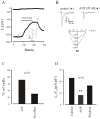
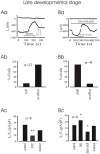
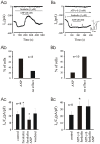
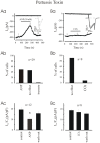
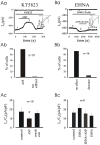
Similar articles
-
Functional expression and regulation of the hyperpolarization activated non-selective cation current in embryonic stem cell-derived cardiomyocytes.J Physiol. 2000 Mar 1;523 Pt 2(Pt 2):377-89. doi: 10.1111/j.1469-7793.2000.t01-2-00377.x. J Physiol. 2000. PMID: 10699082 Free PMC article.
-
Compartmentalization of cardiac beta-adrenergic inotropy modulation by phosphodiesterase type 5.Circulation. 2007 Apr 24;115(16):2159-67. doi: 10.1161/CIRCULATIONAHA.106.643536. Epub 2007 Apr 9. Circulation. 2007. PMID: 17420342
-
cGMP-dependent protein kinase mediates stimulation of L-type calcium current by cGMP in rabbit atrial cells.Cardiovasc Res. 2000 Nov;48(2):310-22. doi: 10.1016/s0008-6363(00)00178-4. Cardiovasc Res. 2000. PMID: 11054477
-
Protein kinase-dependent and Ca(2+)-independent cAMP inhibition of ANP release in beating rabbit atria.Am J Physiol Regul Integr Comp Physiol. 2002 May;282(5):R1477-89. doi: 10.1152/ajpregu.00316.2001. Am J Physiol Regul Integr Comp Physiol. 2002. PMID: 11959692
-
Regulation of the L-type Ca2+ channel during cardiomyogenesis: switch from NO to adenylyl cyclase-mediated inhibition.FASEB J. 1999 Feb;13(2):313-24. doi: 10.1096/fasebj.13.2.313. FASEB J. 1999. PMID: 9973319
Cited by
-
Physical Exercise and Cardiac Repair: The Potential Role of Nitric Oxide in Boosting Stem Cell Regenerative Biology.Antioxidants (Basel). 2021 Jun 23;10(7):1002. doi: 10.3390/antiox10071002. Antioxidants (Basel). 2021. PMID: 34201562 Free PMC article. Review.
-
Electrical Ventricular Remodeling in Dilated Cardiomyopathy.Cells. 2021 Oct 15;10(10):2767. doi: 10.3390/cells10102767. Cells. 2021. PMID: 34685747 Free PMC article. Review.
-
RNA sequencing analysis and atrial natriuretic peptide production in patients with dilated and ischemic cardiomyopathy.PLoS One. 2014 Mar 5;9(3):e90157. doi: 10.1371/journal.pone.0090157. eCollection 2014. PLoS One. 2014. PMID: 24599027 Free PMC article.
-
A SPLUNC1 Peptidomimetic Inhibits Orai1 and Reduces Inflammation in a Murine Allergic Asthma Model.Am J Respir Cell Mol Biol. 2022 Mar;66(3):271-282. doi: 10.1165/rcmb.2020-0452OC. Am J Respir Cell Mol Biol. 2022. PMID: 34807800 Free PMC article.
-
The potential role of atrial natriuretic peptide in the effects of Angiotensin-(1-7) in a chronic atrial tachycardia canine model.J Renin Angiotensin Aldosterone Syst. 2016 Mar 23;17(1):1470320315627409. doi: 10.1177/1470320315627409. Print 2016 Jan-Mar. J Renin Angiotensin Aldosterone Syst. 2016. PMID: 27009283 Free PMC article.
References
-
- Nilius B, Boldt W, Benndorf K. Properties of aconitine-modified sodium channels in single cells of mouse ventricular myocardium. Gen Physiol Biophys. 1986;5:473–484. - PubMed
-
- Kohya T, Tomita F, Itoh K, Suzuki Y, Kawabata N, et al. Silent myocardial ischemia during Holter monitoring in ischemic heart disease. Jpn Circ J. 1989;53:1399–1406. - PubMed
-
- Semmekort B, Guignard JP. Atrial natriuretic peptide during early human development. Biol Neonate. 1991;60:341–349. - PubMed
-
- Brenner BM, Ballermann BJ, Gunning ME, Zeidel ML. Diverse biological actions of atrial natriuretic peptide. Physiol Rev. 1990;70:665–699. - PubMed
-
- Chinkers M, Garbers DL, Chang MS, Lowe DG, Chin HM, et al. A membrane form of guanylate cyclase is an atrial natriuretic peptide receptor. Nature. 1989;338:78–83. - PubMed
MeSH terms
Substances
LinkOut - more resources
Full Text Sources
Miscellaneous

